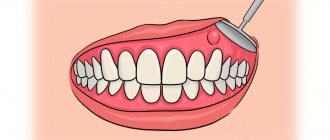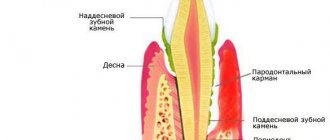The inflammatory process of the periodontal soft tissues that occurs during complicated or improper teething is called pericoronitis. Inflammation during teething can occur in both adults and children, regardless of the location of the problem tooth, but most often pericoronitis of the wisdom tooth develops (it is also often called the “eight” or third molar).
Causes of inflammation and swollen gums during teething
The main prerequisites for the development of pericoronitis are:
- Mechanical injuries to the gingival tissue over the tooth germs due to hard foods, too hard toothbrushes, as well as due to other damaging factors.
- Long-term or difficult teething.
- Favorable conditions in the mouth for the accumulation of bacterial plaque and food particles under the gingival margin (insufficient hygiene, peculiarities of microflora in the oral cavity).
Swollen gums during teething are easily susceptible to traumatic influences, which leads to the development of inflammation. In this case, teething itself can be difficult for the following objective reasons:
- Dense bone tissue in the “eight” zone; bone compaction is most often formed because there are no milk teeth in this zone.
- There is not enough space for the “eight” in the dentition.
- Thickening of the gums and periosteum in the posterior part of the jaw is usually explained by the characteristics of embryogenesis.
Even one of these factors can cause the disease.
Features and risk factors
During difficult and prolonged eruption, the tooth germ practically does not change its position, and a significant part of its chewing surface is covered with a flap of gingival or mucoperiosteal tissue, the so-called “hood”. The flap covering the tooth germ forms a kind of pocket in which food debris and bacterial plaque accumulate. A moist nutrient medium creates optimal conditions for the intensive reproduction of pathogenic microorganisms, which, in turn, actively secrete waste products that are toxic to our body. This provokes the development of an infectious-inflammatory process in the tissues surrounding the problematic tooth germ.
Most often, inflammation of the gums occurs when a wisdom tooth erupts in the lower jaw, which is due to the anatomical structure of the jaw and the lack of space for third molars. In modern people, the jaw arch is approximately 1-1.2 cm smaller than in our distant ancestors, but the size of the teeth has remained the same. This is why the “eights” are cut much later, when the body as a whole and the dental system in particular have already formed - and because of this, it is difficult for the new tooth to find the “right” place on the dental arch.
Since wisdom tooth pericoronitis is the most common type of disease, people over the age of 18 are primarily at risk (usually “eights” are cut at the age of 20-25, but for some this process can take up to 30 years) . As for pericoronitis in children, it usually occurs against the background of insufficient oral hygiene in a child or with infectious diseases of the oral cavity (caries, gingivitis, stomatitis), which complicate teething in children and require treatment. Accumulations of plaque and hard dental deposits significantly increase the risk of developing the disease, so timely and regular removal of tartar can serve as a good preventative method.
Reasons for the formation of an abscess
Young children do not properly care for their oral cavity. Poor brushing of teeth promotes the accumulation and proliferation of bacteria. Penetrating into the tissue, they provoke the development of inflammatory processes, including a purulent lump.
Other factors also influence the formation of an abscess:
- New teeth.
In some babies, the eruption of baby teeth is preceded by the appearance of small tumors filled with white fluid. If such a lump on the child’s gum does not hurt, then there is no reason to urgently consult a doctor.
- Gum injury.
Damage occurs due to the active lifestyle of babies, solid foods or accidental biting. The injured area becomes red and inflamed. Usually everything goes away on its own, but sometimes, when an infection occurs, ulcers and lumps appear.
- Oral diseases:
- caries;
- pulpitis;
- periostitis;
- cyst;
- fistula;
- gingivitis;
- periodontitis.
Inflammatory processes on the gums are often accompanied by abscesses. Purulent complications can be avoided by promptly consulting a doctor.
Pericoronitis, symptoms and types
With pericoronitis, the symptoms largely depend on the form of the disease - acute or chronic. Acute pericoronitis is characterized by:
- Aching intense pain in the area of the cutting tooth, the pain intensifies under the influence of food and mechanical irritants (hygienic procedures, chewing, touching, etc.).
- Difficulty chewing food, complicated swallowing. A few days after the onset of inflammation, it becomes difficult to open the mouth and severe pain appears.
- Swelling and hyperemia of the mucous membrane.
- Enlargement of regional lymph nodes, sometimes the lymph nodes become painful when touched.
- Externally noticeable swelling of the cheeks a few days after the onset of the inflammatory process.
- General deterioration in health - weakness, lethargy, prolonged low-grade fever (increased temperature to 37-37.5 degrees).
- Bad breath, which is caused by the decomposition of food particles and the active activity of microorganisms in the “hood” space.
Acute pericoronitis can occur in a serous (catarrhal) or purulent form: in the first case, the signs of inflammation are more pronounced, the pain is more intense, and there is no purulent discharge. In the second case, purulent exudate flows freely from the inflammatory focus, due to which tissue tension is somewhat reduced and the symptoms are less pronounced. A person may feel like their condition is gradually improving, when in fact the infection is simply spreading to other tissues in the mouth.
If treatment for acute pericoronaritis was not carried out or was carried out at home, the disease gradually becomes chronic: the severity of symptoms decreases, while exacerbations of pain and discharge of pus into the oral cavity are periodically observed. In this case, there is a high risk of developing severe complications.
Types of gingivitis in children
So that the doctor can create the most complete picture, there are several classifications of the disease. Each type has its own clinical characteristics, methods of care and arises due to various factors. After treatment, strict monitoring is required to avoid relapse. This is especially true for children, because they are not able to carry out hygiene and other procedures on their own, so all the doctor’s recommendations fall on the parents.
Catarrhal
It is associated with age-related changes. Most often occurs during primary eruption or in the presence of a concomitant infectious disease. It can be recognized by pain when eating and bleeding when cleaning. An unpleasant odor and loss of taste sensitivity appear. The child may complain of burning and itching in the mouth. On examination, you can see redness.
Marginal
Most often observed in children with abnormal dentition and malocclusion. Because of this, it may be impossible to thoroughly clean all hard-to-reach places where plaque begins to accumulate and pathogenic microflora multiply. Bleeding is noticeable, and in the early stages there is virtually no pain or redness. The attachment of the gums to the teeth is not disturbed. In advanced cases it can become chronic.
Desquamative
The appearance is associated with hormonal disorders and most often occurs during puberty. May occur against the background of other diseases:
- lichen planus;
- pemphigus vulgaris;
- permanent infections.
In the early stages, other than bleeding during cleaning, no symptoms are observed. During the transition period, the gums swell greatly and acquire a bright shade and shine. In complex and advanced cases, purulent ulcers and erosion appear.
Hypertrophic
A complicated form that occurs against the background of a long-term inflammatory process that has entered the chronic stage. The redness will be pronounced, it is impossible to miss or not notice it during examination. The taste of food will be practically lost due to constant bleeding and the taste of blood in the mouth.
Ulcerative
Appears if there has already been primary inflammation in the oral cavity - stomatitis. Concomitant factors include severe hypothermia and decreased immunity. At the same time, the child’s condition worsens sharply; he feels pain in his gums and cannot swallow. Due to the inflammatory process, not only the gum tissue, but also the tonsils can swell. Upon examination, you can see ulcers with a serous putrefactive coating.
Atrophic
It often manifests itself as a medical error during poor-quality orthodontic treatment. An abnormal attachment of the frenulum may also be a provoking factor.
The child's condition will be stable, there are practically no signs of inflammation. You may notice only mild redness, exposed teeth and increased sensitivity to hot foods.
Complications of the disease
In the case when treatment of the gums during complicated tooth eruption was not carried out, serious complications of the inflammatory process develop:
- Periostitis, or flux, is inflammation of the periosteum.
- Osteomyelitis - in this disease, inflammation affects both the bone tissue itself and the bone marrow, gradually leading to bone resorption. This can cause abnormal jaw fractures.
- An abscess when the infection spreads to nearby tissues. Purulent inflammation leads to the melting of muscles and fatty tissues with the formation of a large accumulation of pus.
- Cellulitis is the next stage of a purulent process after an abscess, which does not have clear boundaries. Such purulent inflammation is a serious threat to the patient and is treated in a maxillofacial hospital.
These complications are usually difficult to treat, require a serious systemic approach and can lead to irreversible consequences. Therefore, if a person suspects he has pericoronitis, treatment should begin without delay in order to prevent the condition from worsening. You need to be especially careful if gum inflammation occurs during teething in children, since the children's immune system is still immature, the body's resistance to infections is lower and the process quickly becomes more severe.
Causes of gum inflammation in children
The most common cause of gum disease in children, according to experts, is poor oral hygiene. Teach your baby to brush his teeth correctly and instill in him the habit of doing it regularly, and the likelihood of encountering inflammatory processes in the gums will become much lower.
If you are sure that everything is fine with the hygiene of your child’s teeth and gums, it makes sense to look for other reasons. It can be:
- insufficient intake of minerals and vitamins into the body;
- hormonal disorders;
- hereditary diseases and pathologies in the activity of other organs: the digestive system, cardiovascular system, etc.;
- malocclusion;
- wearing braces or other orthodontic devices;
- mouth breathing;
- damage to the gums by sharp edges of teeth with carious cavities;
- decreased immunity due to infectious diseases.
In any case, only a doctor can correctly understand the symptoms and prescribe treatment, so you should not put off visiting the dental clinic for too long.
Pericoronitis, treatment in children and adults
It should be noted right away that for pericoronitis, treatment at home can only reduce the symptoms of inflammation, but not solve the problem. Therefore, all home methods (rinsing with antiseptics, applying anti-inflammatory ointments, etc.) can only be used as a way to relieve inflammation during the eruption of wisdom teeth and reduce pain - this is a temporary measure before visiting the dentist.
In a dental clinic, in case of complicated teething, treatment will depend on whether the problem tooth should be preserved or whether it should be removed. If preserved, the doctor performs surgical excision of the “hood” under local anesthesia. This eliminates conditions for the accumulation of food and the growth of bacteria, and also facilitates teething. After excision of the “hood,” the patient is prescribed antiseptic therapy (rinses, baths) and, if necessary, antibiotic therapy.
In cases where tooth extraction is indicated due to their incorrect position on the jaw, lack of antagonists, or insufficient space for full eruption, the doctor immediately removes the problematic tooth and prescribes antiseptic therapy to the patient.
In some cases, at the initial stages of the inflammatory process, conservative therapy can be preliminarily applied - local treatment with antiseptic rinses and the introduction of an iodoform tampon into the “hood”. However, local therapy does not always give a positive result; moreover, it is appropriate only at the initial stage of the disease; in other cases, surgical intervention will be required.
When it comes to teething in children, treatment is always aimed at preserving the teeth (except for those cases when dystopia is clearly expressed and the doctor sees that preserving is useless).
Diagnostic features
History of the disease Pericoronitis sometimes looks like a completely different disease of the oral cavity - for example, its symptoms can be confused with periodontitis (inflammation of the peri-apical tissues of the oral cavity) or pulpitis (inflammation of the dental pulp). The pain in these diseases is very similar, and periodontitis is often accompanied by hyperemia and swelling of the gums. One disease can be distinguished from another by the following signs: with pulpitis there is no pain when opening the mouth and no noticeable swelling of the gums, and periodontitis develops only at the tops of the roots of fully erupted teeth. You also need to pay attention to the presence of a characteristic “hood” - a photo will help you assess how it looks with pericoronaritis.
Prevention
In some cases, especially when it comes to inflammation of the gums during teething in children, preventive measures will help prevent the disease: careful regular oral hygiene, timely removal of tartar and soft deposits, visits to the dentist for diagnostic examinations at least once every six months.
If pericoronitis is caused by the anatomical features of the structure of the dental system and the lack of space for the lower “eights” on the dental arch, preventive measures will only smooth out the course of the inflammatory process (due to timely cleaning of the oral cavity from bacterial plaque and food particles that create favorable conditions for inflammation) and identify the problem in time (subject to regular dental examinations).
Causes
Gum inflammation is caused by bacteria and viruses. The most common cause is bacterial flora found in dental plaque. Deposits accumulate on teeth and gums due to insufficiently thorough oral hygiene measures. These bacteria actively produce mediators that cause intense inflammation, as well as toxins. Children who do not brush their teeth for 24 hours are enough for inflammatory changes to begin.
In addition to the etiological factor, there are factors that contribute to the development and progression of inflammatory reactions.
These include:
- defects in the location and attachment of the frenulum of the tongue and lips;
- impaired nasal breathing when the child breathes through the mouth;
- correction of bite with orthodontic devices;
- injury to the oral mucosa by sharp edges of carious defects;
- anomalies in the development of the dental system (malocclusion, diastema, crowding, ectopia);
- violation of filling technology (the edges of the filling hang over).
These factors create difficulties for oral hygiene. They promote the formation, accumulation of dental plaque, and the proliferation of bacteria in it.
Classification
Gingivitis is divided into acute and chronic forms according to the nature of the inflammatory process.
Based on the degree of changes in the mucosa, the following options are distinguished:
- catarrhal;
- ulcerative;
- hypertrophic;
- atrophic.
According to the degree of distribution, they are distinguished: mild (damage to one gingival papilla), moderate (damage to the edge of the entire gum), severe (damage to the entire gum).









